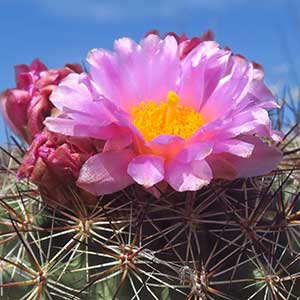Pediocactus nigrispinus
Pediocactus paradinei
black-spine snowball cactus, Columbia Plateau cactus, dark-spine ball cactus, snowball cactus
houserock cactus, Kaibab pincushion cactus, park hedgehog cactus
depressed-ovoid to elongate-ovoid, 5–30 × 5–15 cm;
areoles oval, villous.
subglobose to globose, 3–7.5 × 2.5–5.5(–8) cm;
areoles circular to oval, villous.
smooth, hard and rigid, distinguishable as radial and central;
radial spines 10–30 per areole, spreading at right angles to tubercles, nearly straight, white to dull reddish brown, 8–20 mm;
central spines 6–12 per areole, widely spreading or nearly erect, reddish brown to nearly black, rigid, straight or slightly curved, base yellow or cream, 15–35 mm, less than 1 mm diam. at base.
smooth, thin and flexible, sometimes distinguishable as radial and central;
radial spines 13–22 per areole, straight or curving irregularly, white, 20–25 × 0.2–0.3 mm;
central spines 3–6 per areole, dense in mature plants, white to pale gray, straight, flexible, hairlike, 8–35 × 0.3 mm.
1–3.5 × 2.5–5 cm;
scales and outer tepals of flower tube minutely toothed, laciniate, or entire and undulate;
outer tepals with greenish brown midstripes, oblong-cuneate, 12–25 × 4.5–9 mm;
inner tepals white, pink, magenta, yellow, or yellow-green, 19–27 × 5–10 mm.
1.5–2.2 × 1.9–2.5 cm;
scales and outer tepals minutely toothed or denticulate or entire and undulate;
outer tepals brown midstripes with pale or white margins, oblanceolate, 8–20 × 3–6 mm;
inner tepals light yellow to pink, oblanceolate, 15–20 × 4–6 mm.
green tinged with red, drying reddish brown, short cylindric, 6–11 × 5–10 mm.
greenish yellow maturing to reddish brown, cylindric, 7–10 × 5–8 mm.
gray to black, 2–3 × 1.5–2 mm, papillate but not rugose.
black, 2.5 × 2 mm, papillate but not rugose.
Pediocactus nigrispinus
Pediocactus paradinei
No known morphologic character supports the taxonomic recognition of infraspecific taxa within Pediocactus nigrispinus. Characteristics used to distinguish the three described subspecies almost completely overlap. Pediocactus nigrispinus has been referred to P. simpsonii var. robustior (J. M. Coulter) L. D. Benson, which remains well within the range of variation for P. simpsonii. An unpublished study by J. M. Porter et al. of noncoding chloroplast DNA sequences shows P. simpsonii is less closely related to P. nigripsinus than to P. knowltonii, P. winkleri, and P. despainii.
(Discussion copyrighted by Flora of North America; reprinted with permission.)
Of conservation concern.
Pediocactus paradinei is endemic to the Kaibab Plateau region of northern Arizona.
(Discussion copyrighted by Flora of North America; reprinted with permission.)


